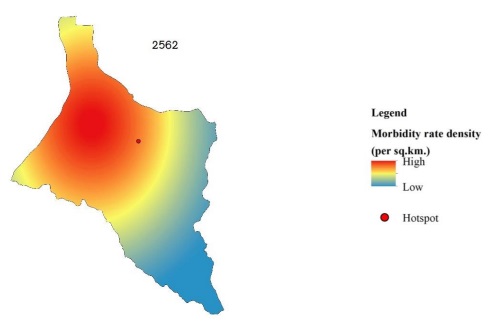The study of factors related to lung cancer incidence and spatial distribution analysis by using Geographic Information System
Keywords:
Geographic Information System, Lung cancer, Mae ka sub-districtAbstract
Cancer is a major public health problem worldwide, especially lung cancer. The main objectives of this study were to study factors associated with lung cancer incidence and to analyze the spatial distribution of lung cancer. A case study of Mae Ka Subdistrict, Mueang District, Phayao Province. The research method is a retrospective research study. The study was conducted on lung cancer patients and non-lung cancer patients in 18 villages, totaling 92 people. These two groups have similar qualities, namely sex, age, and live in the same village. The data was collected by interviewing with the aim of studying three factors: people, behavior, and environment. To examine correlations using broad spatial statistics using Global Moran's I method and analyze risk areas from lung cancer patient data. During the year 2015-2020 from the population-level cancer registry database of Lampang Cancer Hospital. The results were found that the most common age group was those over 60 years old, accounting for 61.96% females higher than males 67.39%. Non-alcoholic behavioral factors accounted for 45.65%, followed by former drinking (20.65%), and drinking once a month or less (16.30%). Environmental factors found that the period of time people lived in most houses was 13-24 hours, representing 53.26%. Most of the residences were single-storey cement houses, representing 43.48%, followed by semi-timbered houses, cement accounted for 30.43%. Most of the walls of the house were cement, accounting for 52.17%, followed by wood and cement, accounting for 32.61%. The Moran spatial correlation statistical analysis, Global Moran's I method, yields between -0.1251 and 0.2988, where acceptable Moran values must be positive. The results showed that the years 2015, 2017 and 2019 had 0.05 or 95% lung cancer incidence concordance, and the lung cancer spatial distribution map in 2019 appeared. Highest in Village No. 12, Ban Mae Ka Hua Thung. Provincial health officials can use the results of this study as a roadmap for monitoring, monitoring, monitoring and preventing lung cancer in the future.
References
Chen, W., Zheng, R., Zeng, H. and Zhang, S. (2015). Epidemiology of lung cancer in China. Thoracic Cancer, 6, 209-215.
Chaikaew, N., Tripathi, N. K., & Souris, M. (2009). Exploring spatial patterns and hotspots of diarrhea in Chiang Mai, Thailand. International Journal of Health Geographics, 8(36). 1-10.
Ferlay, J., Soerjomataram, I., Dikshit, R., Eser, S., Mathers, C., Rebelo, M., et al. (2014).
Cancer incidence and mortality worldwide: sources, methods and major patterns in GLOBOCAN 2012. Int. J. Cancer, 136(5), E359-E386.
Jeefoo, P., Tripsthi, N. K., & Souris, M. (2011). Spatio-temporal Diffusion Pattern and Hotspot Detection of Dengue in Chachoengsao Province, Thailand. International Journal of Environmental Research and Public Health, 8(1), 51-74.
Jeefoo, P. (2012). Spatial Temporal Dynamics and Risk Zonation of Dengue Fever, Dengue Hemorrhagic Fever, and Dengue Shock Syndrome in Thailand. International Journal of Modern Education and Computer Science, 9, 58-68. DOI: 10.5815/ijmecs.2012.09.08
Jeefoo, P. (2016). Analyzing Spatial Clustering and Hotspots Detection of HIV/AIDS Prevalence using GIS Technology. International Journal of Geoinformatics, 12(1), 65-73.
Kulldorff, M., Heffernan, R., Hartman, J., Assuncao, R., & Mostashari, F. (2005). Space-time permutation scan statistic for disease outbreak detection. Public Library of Science
Medicine, 2(3), 216-224.
Pongnikorn, D., Suwanrungrung, R. and Buasom, R. (2015). Chepter II Cancer incidence in Thailand. In Imsamran, W., Chaiwerawattana, A., Wiangnon, S., Pongnikorn, D., Suwanrungrung, R., Sangrajrang, S. et al., (Eds.), Cancer in Thailand Vol, VIII, 2010-2012 (pp. 5-69). Bangkok: New Thammada Press.
Siegel, R., Ma, J., Zou, Z. and Jemal, A. Cancer statistics 2014. CA Cancer J Clin, 64, 9-29.





